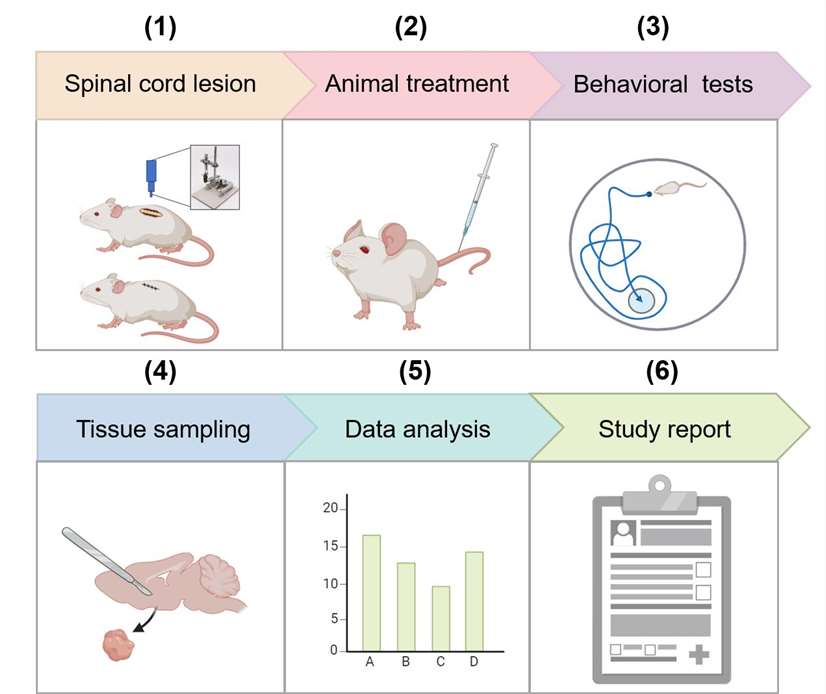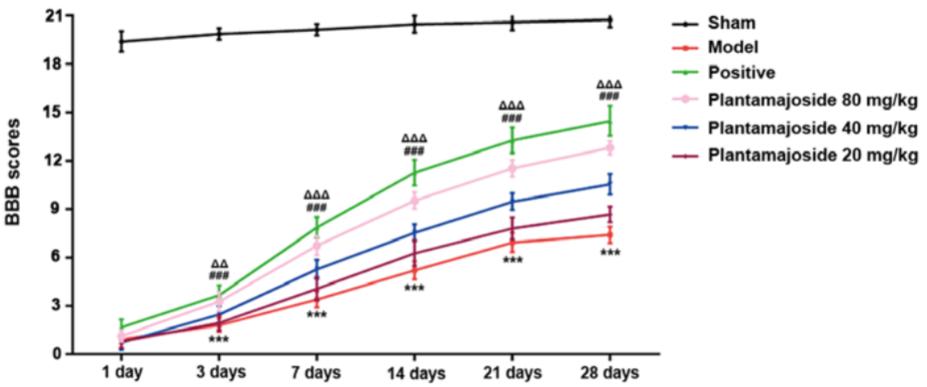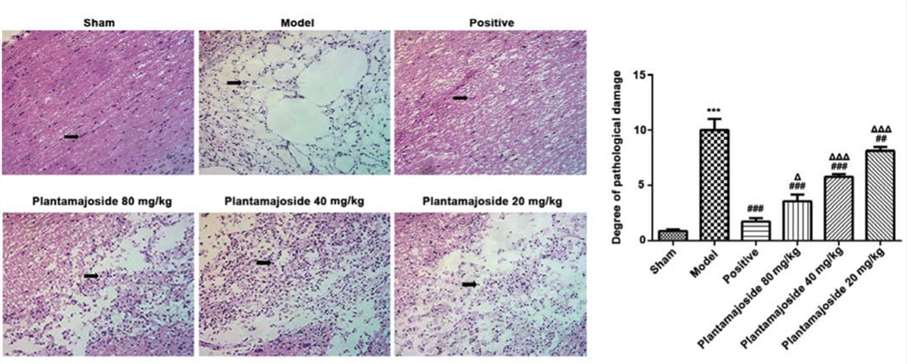Acute Spinal Cord Injury (ASCI) Model
Creative Bioarray, a leading contract research organization, has developed a robust and reliable model to study acute spinal cord injury (ASCI) and evaluate the efficacy of potential therapeutics. The ASCI model serves as a cutting-edge platform for the development of innovative therapies to help individuals suffering from this debilitating condition. Our focus on developing such therapies demonstrates our commitment to improving the lives of patients and advancing the field of medical research.
Acute spinal cord injury (ASCI) is a devastating condition caused by a traumatic injury that bruises, partially tears, or completely tears the spinal cord. It is a common cause of permanent disability and even death in both children and adults. The consequences of ASCI are far-reaching, not only leading to decreased life expectancy and disability but also imposing an enormous financial burden on affected families and society at large. To better understand the underlying mechanisms of ASCI and evaluate the efficacy of experimental therapeutic interventions, ASCI animal model has proved to be invaluable in scientific research.
Our Acute Spinal Cord Injury (ASCI) Model
- Modeling Method
Creative Bioarray uses the controlled impact device to induce contusion to create the ASCI model. - Available Animal
- Rat
- Mouse
- Group Setting
- Sham group
- Model group
- Three dose groups of the test compound
- Endpoints
- Basso-Beattie-Bresnahan (BBB) score
- Histology analysis (spinal cord): H&E staining, IHC
- Mechanical allodynia test
- Behavioral tests
- qPCR and Western Blot
- Other customized endpoints: available upon request
……
 Fig. 1 Workflow of our ASCI model
Fig. 1 Workflow of our ASCI model
Example Data
 Fig. 2 BBB score decreases in the ASCI rat model group and PMS improves the BBB score of ASCI rats
Fig. 2 BBB score decreases in the ASCI rat model group and PMS improves the BBB score of ASCI rats
 Fig. 3 Plantamajoside alleviates the pathological morphology of the spinal cord in rats
Fig. 3 Plantamajoside alleviates the pathological morphology of the spinal cord in rats
Quotation and Ordering
As a leading provider of contract research services for in vivo pharmacology across various disease areas, Creative Bioarray offers dependable and cost-effective study solutions, leveraging either our well-established models or novel ones. Furthermore, we are committed to personalizing and adapting all studies to align with our clients' unique requirements. If you are interested in our services, please do not hesitate to contact us. We are looking forward to cooperating with you now!
Reference
- Hu, H., Jian, X. The protective mechanism of action of plantamajoside on a rat model of acute spinal cord injury. Experimental and Therapeutic Medicine, 2021, 21(4): 1-7.
For research use only. Not for any other purpose.
Disease Models
- Oncology Models
-
Inflammation & Autoimmune Disease Models
- Rheumatoid Arthritis Models
- Glomerulonephritis Models
- Multiple Sclerosis (MS) Models
- Ocular Inflammation Models
- Sjögren's Syndrome Model
- LPS-induced Acute Lung Injury Model
- Peritonitis Models
- Passive Cutaneous Anaphylaxis Model
- Delayed-Type Hypersensitivity (DTH) Models
- Inflammatory Bowel Disease Models
- Systemic Lupus Erythematosus Animal Models
- Oral Mucositis Model
- Asthma Model
- Sepsis Model
- Psoriasis Model
- Atopic Dermatitis (AD) Model
- Scleroderma Model
- Gouty Arthritis Model
- Carrageenan-Induced Air Pouch Synovitis Model
- Carrageenan-Induced Paw Edema Model
- Experimental Autoimmune Myasthenia Gravis (EAMG) Model
- Graft-versus-host Disease (GvHD) Models
-
Cardiovascular Disease Models
- Surgical Models
- Animal Models of Hypertension
- Venous Thrombosis Model
- Atherosclerosis model
- Cardiac Arrhythmia Model
- Hyperlipoidemia Model
- Doxorubicin-induced Heart Failure Model
- Isoproterenol-induced Heart Failure Model
- Arterial Thrombosis Model
- Pulmonary Arterial Hypertension (PAH) Models
- Heart Failure with Preserved Ejection Fraction (HFpEF) Model
-
Neurological Disease Models
- Alzheimer's Disease Modeling and Assays
- Seizure Models
- Parkinson's Disease Models
- Ischemic Stroke Models
- Acute Spinal Cord Injury (ASCI) Model
- Traumatic Brain Injury (TBI) Model
- Hypoxic-Ischemic Encephalopathy (HIE) Model
- Tourette Syndrome (TS) Model
- Amyotrophic Lateral Sclerosis (ALS) Model
- Huntington's Disease (HD) Model
- Intracerebral hemorrhage (ICH) Models
- Schizophrenia Model
- Pain Models
-
Metabolic Disease Models
- Type 1 Diabetes Mellitus Model
- Type 2 Diabetes Mellitus Model
- Animal Model of Hyperuricemia
-
Nonalcoholic Fatty Liver Disease Model
- High-Fat Diet-Induced Nonalcoholic Fatty Liver Disease (NAFLD) Model
- Methionine and Choline Deficient (MCD) Diet-Induced Nonalcoholic Fatty Liver Disease (NAFLD) Model
- Gubra-Amylin NASH (GAN) Diet-Induced Nonalcoholic Fatty Liver Disease (NAFLD) Model
- Streptozotocin (STZ) Induced Nonalcoholic Fatty Liver Disease (NAFLD) Model
- High Fat Diet-Induced Obesity Model
- Diabetic Foot Ulcer (DFU) Model
- Liver Disease Models
- Rare Disease Models
- Respiratory Disease Models
- Digestive Disease Models
-
Urology Disease Models
- Cisplatin-induced Nephrotoxicity Model
- Unilateral Ureteral Obstruction Model
- 5/6 Nephrectomy Model
- Renal Ischemia-Reperfusion Injury (RIRI) Model
- Diabetic Nephropathy (DN) Models
- Passive Heymann Nephritis (PHN) Model
- Adenine-Induced Chronic Kidney Disease (CKD) Model
- Kidney Stone Model
- Doxorubicin-Induced Nephropathy Model
- Orthotopic Kidney Transplantation Model
- Orthopedic Disease Models
- Ocular Disease Models
- Skin Disease Models
- Infectious Disease Models
- Otology Disease Models